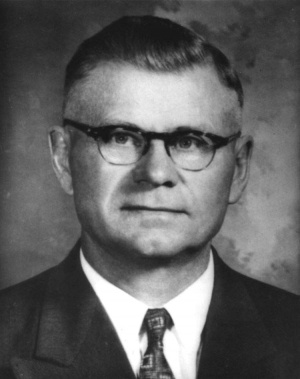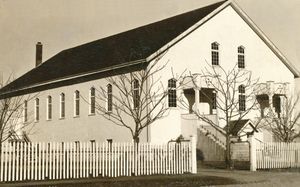Difference between revisions of "Help:Congregations"
SamSteiner (talk | contribs) (Created page with "== How to Write a Congregational Entry == A good congregational entry provides basic factual information, with highlights of major events in the congregation's life. For the G...") |
SamSteiner (talk | contribs) m (Protected "Help:Congregations" ([edit=sysop] (indefinite) [move=sysop] (indefinite))) |
Revision as of 13:27, 7 December 2013
How to Write a Congregational Entry
A good congregational entry provides basic factual information, with highlights of major events in the congregation's life. For the Global Anabaptist Mennonite Encyclopedia Online (GAMEO) the style of writing should be direct, factual and succinct. For questions on style contact an editor or see GAMEO Style Sheet for Authors.
The length for a congregational entry should be 400-500 words. A longer entry for an older "mother" church could be about 600-750 words.
Elements to be considered for a congregational entry
- Current name of congregation, municipality in which located (if not part of name), and province.
- Origin of the congregation -- dates of first meeting, date of formal organization, reasons the congregation was begun, names of person(s) considered to be the founders.
- Milestones in congregational life -- new buildings or relocations (with dates), first pastor, congregational name changes (with dates of change for all name changes), changes in primary language of worship (with dates), divisions within congregation (with a succinct statement of reasons), major programs initiated (e.g. a school, nursery school, refugee program) that have their own identity.
- Particularly interesting anecdotes that would be of interest to persons outside the congregation.
- Describe characteristics of the congregations: leadership style, particular mission and/or service emphases (be specific, e.g. program for street youth, day-care centre, youth drop-in centre, etc.), worship style (e.g. traditional, contemporary, liturgical, etc.), language(s) of worship.
- Pastoral leaders, including dates of service (these will normally be persons who are licensed/ordained and give significant time to congregational leadership; the list may include more than the "senior" pastor). If pastoral leaders are not paid, this could be indicated. (This could also be put into a table form displayed with "Additional information" and could be expanded to other leadership persons in the congregation, e.g. moderator/church chair, Sunday school superintendents, etc.).
- Denominational and area conference affiliations (provide brief explanation if the congregation changed affiliations or withdrew from a conference) and the years of affiliation.
- Membership statistics at five year intervals. If the congregation includes multiple cultural/language groups, this could be indicated with approximate percentages, e.g. 85% Anglo, 15% Hispanic.
- Closure of the congregation (if applicable) -- dates of last meetings, reasons for congregation's closing, details of merger (if joining with another congregation).
- Current address and phone number of the congregation if active (omit phone number if congregation no longer exists; never use a personal phone number). Provide directions to the meetinghouse if there is not a street address. If the congregation is in rented quarters state the name of the school (or other facility) and its location.
- Name(s) of current congregational leader(s).
- Location of congregation's archives (local or denominational archives).
- Published and unpublished sources (this is not to be exhaustive); encyclopedia articles do not need citation of particular annual meeting minutes, for example, but could refer to the congregation's "Annual reports."
- Web address if congregation has a web site.
Not all elements need to be in every congregational entry but each element should be considered. Controversial aspects of a congregation's experience should not be ignored, but dealt with in a factual and balanced manner.
Congregational entries may be accompanied by up to two photographs -- one of the building (either current or historic) and possibly an early leader or a significant event in the congregation's life, e.g. a major fire. Photos should be accompanied by information on photographer, name of person(s) in photo, and date of the photo.
Structure of the Entry
The congregation's name should be used in most paragraphs.
The paragraphs should generally follow the sequence of 1-9, though this can be altered as seems best.
The last paragraph contains current basic factual information on address and phone number and leadership.
Elements 12-13 should be in a separate section titled "Bibliography" and placed after the last paragraph.
If you have questions, please contact any member of the Encyclopedia's Editorial Board.
All submissions are subject to the editorial process of the Global Anabaptist Mennonite Encyclopedia Online Editorial Board
Example
Yarrow Mennonite Brethren Church (Chilliwack, British Columbia, Canada)
The first settlers of Yarrow arrived in February 1928 and began meeting in the homes of Mennonite Brethren and Mennonite Church families. In the summer of 1928 the group began meeting in a one-room public school. The Mennonite Brethren organized as a separate congregation of 96 members on 3 February 1929 with Peter Dyck as the first leading minister. The congregation's first baptism was held 14 July 1929. In 1930 the church was officially accepted into the Northern District conference of the Mennonite Brethren Church, and became a founding member of the B.C. Conference of Mennonite Brethren Churches in 1931.
In 1931 Johann A. Harder was elected to serve as leading minister after Peter Dyck moved to Vancouver. Harder served for 18 years and was also an instrumental leader in the larger Mennonite Brethren conference. Soon after the congregation organized, a significant number of members began holding their own services in neighboring Greendale, formally organizing in 1931 as the Sardis Mennonite Brethren Church (later Greendale Mennonite Brethren).
The Yarrow church quickly organized Elim Bible School in 1930 and hired Peter D. Loewen to be the instructor. Loewen also served as the congregation's Sunday school superintendent for 35 years, overseeing a ministry that at its peak in 1953 included 461 students, 40 classes and 72 teachers. The school ceased operations in 1955. At the high school level the church, in cooperation with the Greendale and Chilliwack MB churches, started Sharon Mennonite Institute in 1945. Owing to the collapse of the raspberry market, this school was closed in 1949. However, by 1951 the Yarrow MB church opened Sharon Mennonite Collegiate, which by 1960 had an enrollment of 114 students in grades six to twelve, along with a staff of seven teachers. The school closed in 1970.
Church leaders were elected by congregational vote. However, in the early years leadership in the church rested in the non-elected church council (Vorberat) comprised of all ordained ministers, whose numbers were considerable. As result of membership agitation, in 1937 the church council was changed so that the congregation elected a majority of its members.
The Yarrow congregation had a strong heart for missions and was active in supporting local and foreign mission endeavors. Local outreach was carried out in Haney, Pitt Meadows and Hope, and members of the congregation were active in the West Coast Children's Mission and the teaching of Daily Vacation Bible School in a number of communities. Funds were foreign missions were raised through missions auctions, and women's fellowship groups were very active in contributing crafts and baked goods to these auctions. Many from Yarrow felt the call to foreign mission fields, including Susie Brucks, Henry and Elsie Brucks, Jacob and Ann Loewen, and Abe and Sara Esau.
Music was a central component of congregational life. The church had several choirs and other musical groups led by H. P. Neufeldt and George Reimer, who was choir director for 24 years. In the early 1940s the youth choir had as many as 90 members. In time Yarrow became known for its musical festivals (Saengerfeste).
The congregation continued to grow through the migration of people from the Canadian Prairie provinces to the Fraser Valley. It completed its first buildings in 1933, but due to the rapid growth of the congregation, a new building was constructed in 1938, followed by a Bible school building in 1946. By 1948 it had become the largest Mennonite Brethren congregation in Canada with a membership of 970. However, the economic recession that affected the raspberry market after 1948 and the flood occurring that year encouraged many families to move elsewhere, especially to Vancouver, and the congregation's size and influence in the larger denomination began to wane. The congregation began to make the transition from German to English with a bilingual service in 1957 and separate German and English services in 1968. In more recent years the church has been revitalized, with an active outreach into the community, and a multi-purpose gymnasium was added to the facility in 1991. In February 2003 it was 85 years since Mennonites began meeting for worship in this community.
Bibliography
Esau, Abram J., Abrahams, Jacob and Abrahams, Tina. "Memoirs of Yarrow Residents." Unpublished essay.
Giesbrecht, David. "The Early Years of the Yarrow Mennonite Brethren Church." 2002.
Klassen, Agatha E. "Brief Historical Overview of the Earliest Mennonite Brethren Churches of the Fraser Valley." Unpublished essay, 1993.
Klassen, Agatha E. "Historical Sketch of the Yarrow Mennonite Brethren Church." Unpublished essay, 1999.
Klassen, Agatha E., ed. Yarrow: A Portrait in Mosaic. Clearbrook, B.C.: Olfert & Sons, 1976.
Loewen, Peter D. "My Experiences in the Yarrow Sunday School." Unpublished essay.
Archival Records
The Archives of the congregation are located at the archives of the Mennonite Historical Society of British Columbia in Abbotsford, BC.
Minutes of the Yarrow Mennonite Brethren Church (1929-1950). Mennonite Historical Society of British Columbia Archives, Abbotsford, BC.
Additional Information
Address: 41995 Yarrow Central Road, Yarrow BC V2R 5E7
Phone: 604-823-6622
Website:
Denominational Affiliations:
British Columbia Conference of Mennonite Brethren Churches (1931-present)
Canadian Conference of Mennonite Brethren Churches (1930-present)
General Conference of Mennonite Brethren Churches of North America (1930-2003)
Yarrow MB Church Pastors
| Minister | Years |
|---|---|
| Peter Dyck |
1929-1930 |
| K. A. Klassen (interim) | 1930-1931 |
| Johann A. Harder | 1931-1949 |
| Henry Bartsch (interim) | 1949-1950 |
| Herman Lenzmann | 1950-1959 |
| Peter P. Neufeldt | 1960-1961 |
| Henry Brucks | 1961-1965 |
| David Friesen | 1965-1967 |
| Henry G. Thielman | 1968-1971 |
| John F. Klassen | 1971-1974 |
| Abe L. Klassen | 1974-1987 |
| Wilf Richert | 1987-1989 |
| Ron Braun | 1989-1997 |
| Jim Nightingale | 1998-2004 |
| Ike Bergen (interim) | 2004-2005 |
| Eldon Fehr | 2005-present |
Yarrow MB Church Membership
| Year | Members |
|---|---|
|
1929
|
96
|
|
1935
|
237
|
|
1940
|
434
|
|
1945
|
740
|
|
1948
|
970
|
|
1950
|
875
|
|
1955
|
761
|
|
1960
|
606
|
|
1965
|
581
|
|
1970
|
430
|
|
1975
|
328
|
|
1980
|
297
|
|
1985
|
287
|
|
1990
|
236
|
|
1995
|
182
|
|
2000
|
162
|

